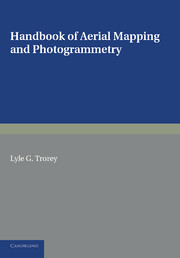Book contents
- Frontmatter
- Dedication
- FOREWORD
- PREFACE
- Contents
- LIST OF TABLES
- Bibliography
- Notation
- CHAPTER 1 PERSPECTIVE PRINCIPLES
- CHAPTER 2 MEASUREMENT OF ANGLES FROM OBLIQUES
- CHAPTER 3 PERSPECTIVE GRID AND FOUR-POINT METHODS
- CHAPTER 4 MEASUREMENT OF HEIGHT FROM A SINGLE OBLIQUE
- CHAPTER 5 VERTICALS: FUNDAMENTAL CONSIDERATIONS OF COVER, PARALLAX AND STEREOSCOPY
- CHAPTER 6 PARALLAX AND ELEVATION CALCULATIONS
- CHAPTER 7 RADIAL-LINE TRIANGULATIONS, GRAPHICAL AND MECHANICAL
- CHAPTER 8 RECTIFICATION MEANS
- CHAPTER 9 SUBDIVISIONS OF AN AIR SURVEY MAPPING OPERATION
- CHAPTER 10 PRINCIPLES OF STEREOSCOPIC PLOTTING INSTRUMENTS
- CHAPTER 11 THE MULTIPLEX PROJECTOR
- APPENDIX 1 STANDARD MAPPING PROCEDURE ROYAL CANADIAN ENGINEERS
- APPENDIX 2 MULTIPLEX AND STEREOPLANIGRAPH: CONSIDERATIONS GOVERNING MINIMUM CONTOUR INTERVAL
- APPENDIX 3 THE KELSH PLOTTER
- INDEX
CHAPTER 9 - SUBDIVISIONS OF AN AIR SURVEY MAPPING OPERATION
Published online by Cambridge University Press: 05 June 2016
- Frontmatter
- Dedication
- FOREWORD
- PREFACE
- Contents
- LIST OF TABLES
- Bibliography
- Notation
- CHAPTER 1 PERSPECTIVE PRINCIPLES
- CHAPTER 2 MEASUREMENT OF ANGLES FROM OBLIQUES
- CHAPTER 3 PERSPECTIVE GRID AND FOUR-POINT METHODS
- CHAPTER 4 MEASUREMENT OF HEIGHT FROM A SINGLE OBLIQUE
- CHAPTER 5 VERTICALS: FUNDAMENTAL CONSIDERATIONS OF COVER, PARALLAX AND STEREOSCOPY
- CHAPTER 6 PARALLAX AND ELEVATION CALCULATIONS
- CHAPTER 7 RADIAL-LINE TRIANGULATIONS, GRAPHICAL AND MECHANICAL
- CHAPTER 8 RECTIFICATION MEANS
- CHAPTER 9 SUBDIVISIONS OF AN AIR SURVEY MAPPING OPERATION
- CHAPTER 10 PRINCIPLES OF STEREOSCOPIC PLOTTING INSTRUMENTS
- CHAPTER 11 THE MULTIPLEX PROJECTOR
- APPENDIX 1 STANDARD MAPPING PROCEDURE ROYAL CANADIAN ENGINEERS
- APPENDIX 2 MULTIPLEX AND STEREOPLANIGRAPH: CONSIDERATIONS GOVERNING MINIMUM CONTOUR INTERVAL
- APPENDIX 3 THE KELSH PLOTTER
- INDEX
Summary
Maps and Surveys
Aerial Photography and Aerial Mapping. In common parlance, and, indeed, in technical literature, the term ‘air survey’ is often used rather loosely when aerial photography is meant. One reads, for example, that an aerial survey of so many hundreds of thousands of square miles was completed. What is meant is that the area in question has been photographed from the air.
Before, however, maps become available there must be ground survey, or the equivalent, the map compilation, and reproduction. The cost of the aerial photography alone is (or should be) of the order of 10-15%, of the total cost of an aerial mapping project, including all the foregoing, a fact which is not very well known.
A thousand square miles can be covered in less than 1 hr. of photographic time (H = 30,000 ft.). Tens of thousands of man-hours of skilled labour may be required for the photogrammetry, mapping, and reproduction. In addition, there may be a season's work for one or more ground-survey parties.
It is well, therefore, to speak of aerial photography, and of aerial mapping, rather than of air survey, so that there may be no confusion as to what, exactly, is meant. Air survey, as used herein, includes the photographic, mapping,and reproduction, operations and, according to the context, the provision of ground control.
Definition of A Map. So far as the dictionary is concerned a map is said to be a representation upon a plane surface of a portion, or of the whole, of the surface of the earth. For the purposes of this discussion the word will be restricted to such a representation, but at a scale where conventional signs—which may differ quite appreciably in size from the object represented —are used to depict detail. For example, on the 1 in. Ordnance Survey map of Great Britain, certain roads are drawn as nearly 60 m. wide, whereas in fact they are much narrower. Features adjacent to such a road cannot therefore be shown in their true relative positions. Objects of importance to the purpose of a map may be conventionalized in size.
- Type
- Chapter
- Information
- Handbook of Aerial Mapping and Photogrammetry , pp. 115 - 121Publisher: Cambridge University PressPrint publication year: 2013



